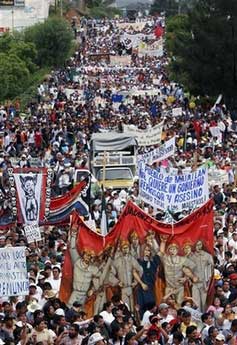Oaxaca, Mexico: Mass march protests police violence
By
Ruth Vela
Published Jun 20, 2006 11:08 PM
Oaxaca, Mexico, state police—armed with tear gas, firearms
and covered by helicopters—moved in hours before dawn the morning of June
14 and forcibly removed thousands of schoolteachers from the plantón, the
location of a protest encampment that had been set up two weeks earlier in the
central plaza of Oaxaca City.
|
400,000 march on June 16 in Oaxaca
to support teachers.
|
Some 40,000 teachers have been on strike
since May for higher wages. They are now demanding that the governor of Oaxaca
State be impeached.
Witnesses said police fired into the crowd, and local
media reports claim two dead. Police fired large amounts of tear gas
indiscriminately into the crowd, including from police
helicopters.
Reports are that 92 people were injured by the police
assault. A pregnant woman suffered a miscarriage as a result of the police
violence.
Although the local citizens have re-occupied the city’s
central square, there have been reports of people being killed by the police,
with many others injured, arrested or “disappeared.” According to
state officials, two police officers were also being held hostage by teachers.
If true, this is an indication that the teachers are not taking the police
attack lightly.
Mexico City leaders of the National Coordinating Body of
Educational Workers (CNTE) also said that two teachers had been killed in the
attack, and six “disappeared.” (El Universal, June 15) Meanwhile
Oaxaca Gov. Ulises Ruiz Ortiz had the audacity to deny in an official TV and
radio address that any teachers had been killed.
Mexican President
Vicente Fox refused to condemn the police action. Presidential spokesperson
Ruben Aguilar Valenzuela said the federal government “respects the
sovereignty” of the states, adding, “Never again will we have the
presidential authoritarianism, never again the centralism; we have embraced
democracy and we now have real federalism.”
That same day five
airplanes with 700 elite Federal Preventative Police landed in
Oaxaca.
Since the attack, the third teachers’ mega-march in Oaxaca
took place on June 16. It brought out all sectors of civil society in a vast
repudiation of the governor’s repressive policies.
The march,
hundreds of thousands strong, was the direct response to the brutal June 14
police attack on the strikers’ encampment—an attack that is being
called “the straw that broke the camel’s back.”
Yet for
many, the Oaxaca attack it is just typical violence, similar to what has been
seen in years past in Mexico and also sadly in the very recent past as well. In
May, police suppressed a rebellion in San Salvador de Atenco, a town near Mexico
City. Demonstrators opposed the government’s efforts to evict flower
vendors who were selling without official permits. Two protesters died in the
crackdown. Also, in April two steel workers were killed in battles with police
sent in to break a strike, part of a long and bitter nationwide work stoppage by
miners and metal workers.
Presidential spokesperson Aguilar said the
upheaval in Oaxaca, like the previous incident in San Salvador de Atenco, was
not a sign of instability around the upcoming presidential election. For their
part, the 40,000 teachers vowed to continue the strike, and have threatened to
disrupt the presidential election voting in Oaxaca.
Articles copyright 1995-2012 Workers World.
Verbatim copying and distribution of this entire article is permitted in any medium without royalty provided this notice is preserved.
Workers World, 55 W. 17 St., NY, NY 10011
Email:
[email protected]
Subscribe
[email protected]
Support independent news
DONATE


